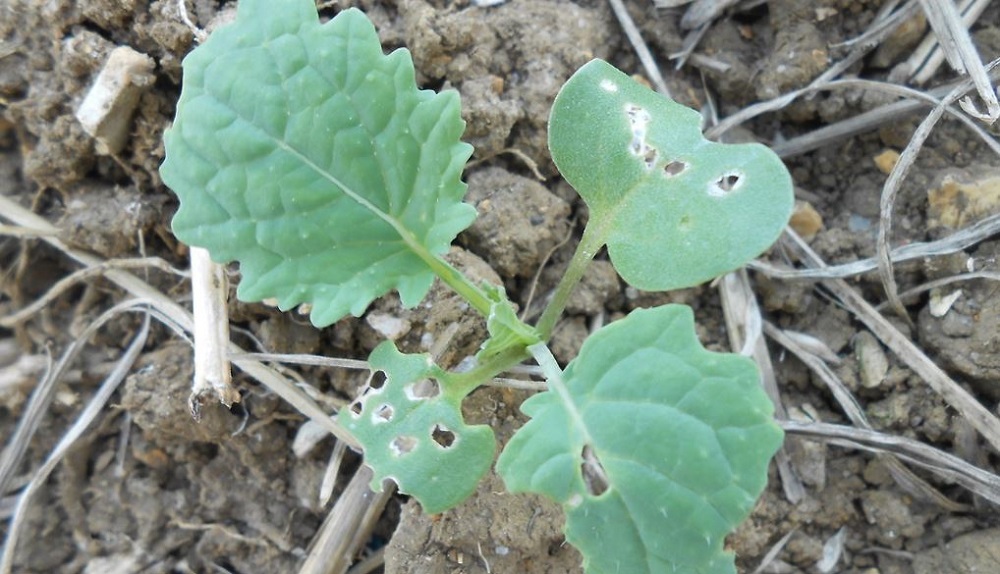Pre-sowing tips to tackle cabbage stem flea beetle in oilseed rape
Friday, 26 July 2024
Sacha White provides tips to help protect your next crop of winter oilseed rape from cabbage stem flea beetle (CSFB).
We published the Planting and Variety Survey results for harvest 2024 earlier this month. It confirmed what many thought: the winter oilseed rape area took another pummelling. Compared to harvest 2023, the area may have declined by as much as 21% to 307,000 ha. This is potentially the second-lowest crop area in at least two decades and 59% below the peak area in 2012.
For the first time in several years, CSFB may not have been the main culprit, more the record-breaking wet weather (and tightening crop margins). However, the pest certainly played its part.
As crops are harvested, farmers will embrace the hope of the next crop, building upon experience and wishing for a helping (not hindering) hand from Mother Nature.
But what are the main lessons for CSFB management? Well, we know more than ever about the habits of the critter and how these can be manipulated to our advantage.
For instance, we have a much better handle on migration. Adult beetles tend to migrate into crops in earnest in late August or early September, peaking soon after (early-to-mid September), before tailing off quickly towards the end of September.
The migration pattern means that late-August to mid-September is the highest-risk window for sowing.
Sowing early
Crops sown early (before the last week of August) can establish well before the beetle arrives in troubling numbers.
All but the youngest plants can tolerate considerable feeding. For example, plants at growth stage 14 (four leaves unfolded) can readily withstand 50% leaf area lost or more, providing soil moisture is not limiting for growth.
Slow and uneven growth means relatively few beetles can cause high levels of damage (especially if they pick off plants as they push through the soil surface).
It is also important to know that early sown crops provide more opportunities for egg laying, and such crops tend to have higher larval loads.
Selecting a variety with good vigour, especially one that grows away from larval feeding in the spring, will help compensate for increased larval pressures.
Sowing late
Crops sown late (from mid-September) tend to emerge after migration has peaked.
Drilling later is a diversion tactic. Beetles land in earlier sown crops (or oilseed rape volunteers) instead, where they stay – their wing muscles deteriorate, helping them expend more energy on developing eggs.
As a result, later-sown crops are associated with much less adult feeding damage. The cooler temperatures also reduce egg numbers and subsequent larval populations.
Selecting a variety with good autumn vigour is wise strategy when sowing later.
Sowing trials
A recent ADAS-led trial (as part of AHDB project 21120185) showed that changing sowing dates by just a few weeks could be the difference between a 0 t/ha (total crop loss) and a more than 5 t/ha crop.
The trial used three sow dates: early (26 August), middle (6 September) and late (15 September). The middle treatment coincided with peak migration and got wiped out by adult feeding. In contrast, the early and late-sowing dates recorded just 7% and 3% leaf area lost (and 3.8 t/ha and 5.5 t/ha) respectively.
As predicted, the early sown crop had the highest larval pressure – 19 times higher than the crop sown on 6 September.
However, CSFB monitoring data from several years shows that the peak migration varies, which adds to the management headache.
In these trials, if migration occurred slightly earlier or conditions were drier, then the early sown crop could have got hammered. The same holds true for delayed migration in later-sown crops.
What does this mean for practice? Well, at present, you need to assume that the year will deliver a typical migration pattern and use a range of sow dates to spread risk across your winter oilseed rape fields.
AHDB is investigating the potential to provide data on migration status this year (watch this space).
Companion crops
Following anecdotal reports that companion crops could play a role in CSFB management, the ADAS-led project also used trials to provide evidence to support (or reject) the approach.
Results from five companion crop trials showed it was possible to consistently produce modest reductions in CSFB pressure: up to 47% fewer adults, up to 52% less adult feeding damage and up to 48% fewer larvae.
- Sowing companion crops one to two weeks ahead of oilseed rape helped maximise the protectant effect
- Buckwheat on its own or with berseem clover generally performed best
How it works isn’t completely clear. It is likely that they make it harder for beetles to locate oilseed rape, they may also provide a habitat for natural enemies of CSFB.
CSFB IPM
A lack of effective chemical options has made this beetle pest enemy number one in winter oilseed rape. Its management relies on layering a developing, variable and complex set of alternative solutions.
This is the first in a series of CSFB IPM articles, which aims to provide you with a solid foundation for experimentation at the farm level to help you grow oilseed rape with more confidence.
As with all cultural approaches, control can vary. Please let us know about your experiences, so we can build the best understanding of all interventions.
 AHDB
AHDB


